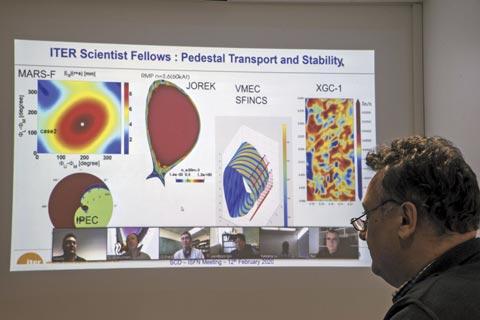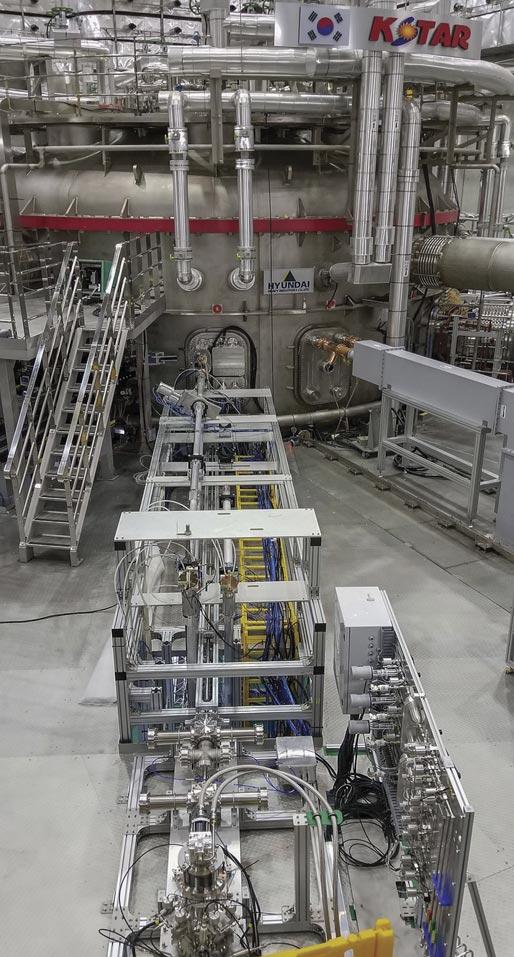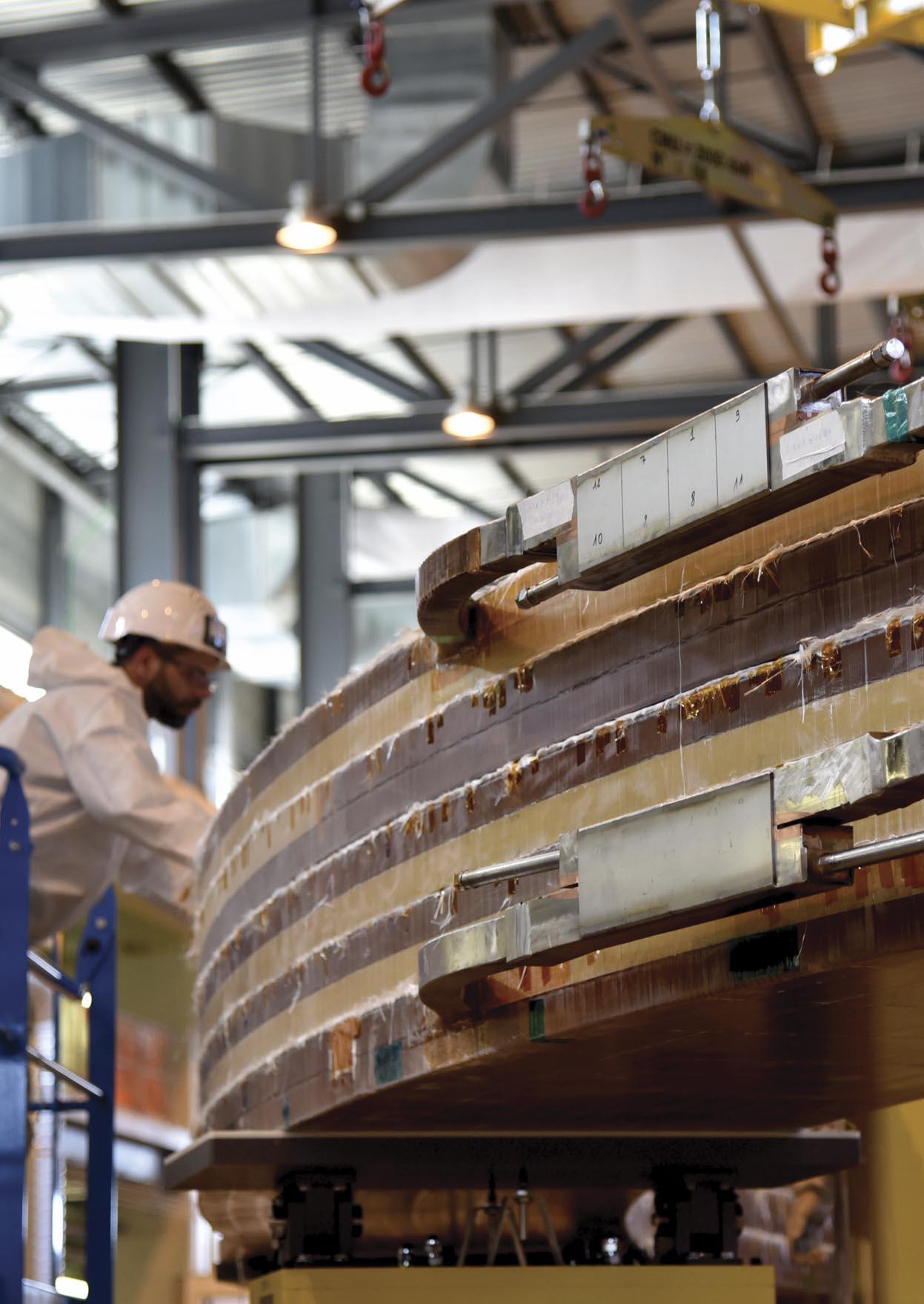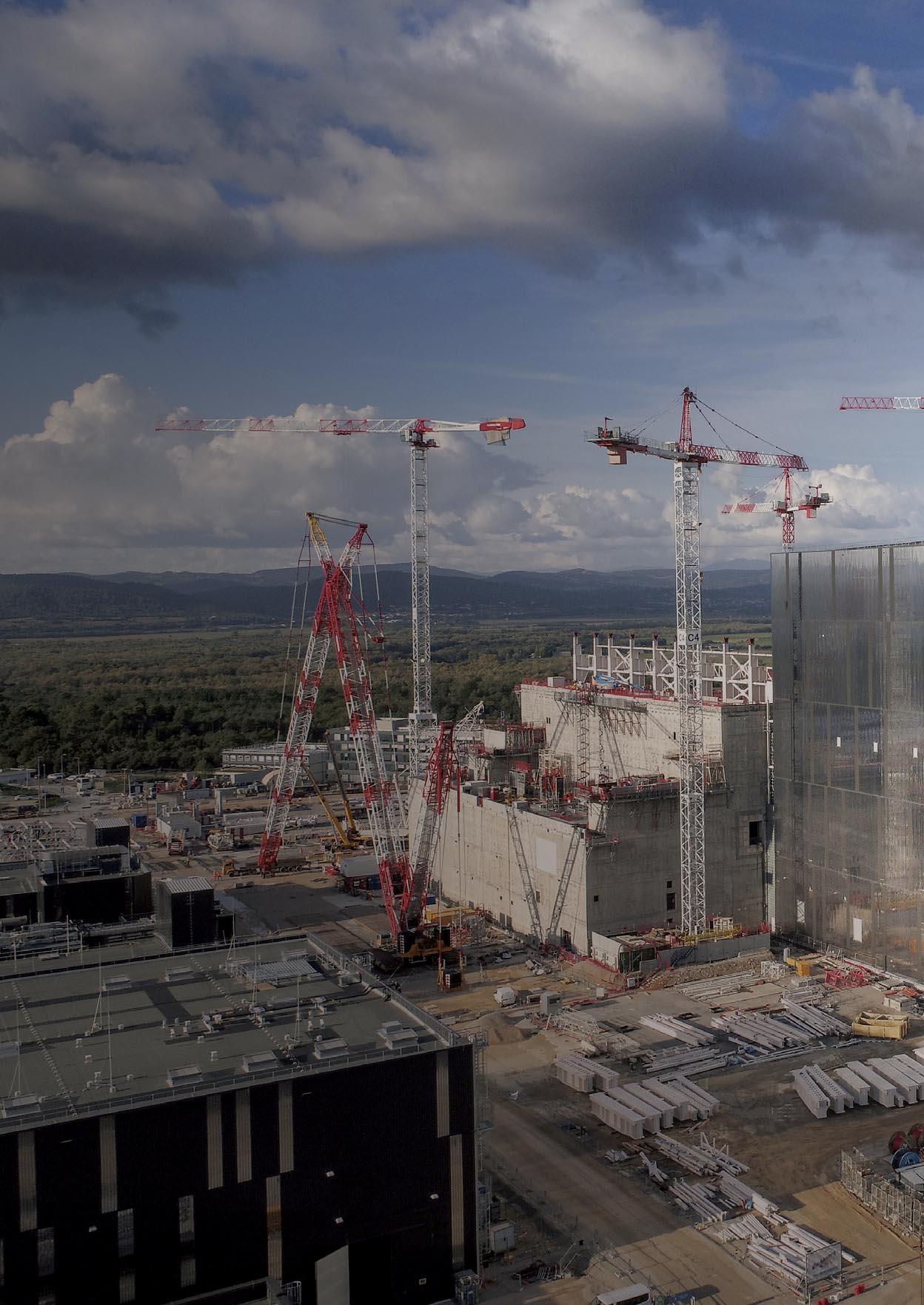
8 minute read
ITER Science
ITER SCIENCE
TESTING SHATTERED PELLET INJECTION
Advertisement
When operating tokamaks of the size of ITER, one of the key systems to ensuring reliable and successful operation from the very first campaign is the disruption mitigation system.
A disruption occurs when an instability grows in the tokamak plasma to the point where there is a rapid loss of the stored thermal and magnetic energy. This rapid loss can also accelerate electrons to very high energy (socalled “runaways”). To lessen the impact of high-energy plasma disruptions that can lead to significant thermal loading of in-vessel components, ITER will need a robust disruption mitigation strategy.
ITER’s disruption mitigation strategy is based on the injection of cryogenic pellets from different toroidal locations into plasmas that are unstable and will disrupt – a technique called shattered pellet injection. Just before they enter the plasma chamber, these pellets are shattered into small fragments. This shattering ensures that the frozen deuterium and neon is ablated and assimilated by the plasma to achieve the high densities that are required for disruption mitigation. The plasma thermal and magnetic energy will be dissipated through radiation rather than leading to large heat loads and electromagnetic forces.
In 2019, a single shattered pellet injector started operating on the European JET tokamak, while an ITER-like dual-injection configuration was installed on the KSTAR tokamak in Korea (photo). Experiments on these two devices will help to design ITER's disruption mitigation system by exploring the optimum configuration of the injectors, the amount of shattered pellet material, the timing and the penetration of the pellets.


AN ARMY OF EXPERTISE FOR ITER
In the area of cutting-edge research – and particularly the sophisticated modelling of plasmas – the project is benefitting from the assistance of world-renowned experts through the ITER Scientist Fellow Network program. Now into its fourth year, the program is beginning to produce concrete results.
Since the launch of the ITER Scientist Fellow Network in 2016, more than 60 experts from the fusion laboratories and universities of the ITER Members have agreed to apply
Each opening in the cryostat lines up with a similar opening in the concrete bioshield (page 28-29). A detailed experimental program is planned in stages, from 2025 through 2041.

According to an agreement concluded this year with host Consorzio RFX, first-phase results at the ITER Neutral Beam Test Facility in Padua, Italy, (pictured) will inform the procurement of ITER’s neutral beam injection components. In a second phase, the facility will serve as a testbed for enhancing system performance.

ITER SCIENCE
their expertise to solving some of ITER’s high-priority research needs in the areas of simulation and theory. While remaining employed by their home institutions, they have long-term access to ITER Headquarters and spend part of their time on site working with ITER staff.
The Fellows focus on areas of interest to the ITER team but that also advance their own research objectives –for example, developing new models to apply to plasma simulations or using known codes in novel ways. Every scientist has an annual work plan, and attends one or
A NEW TOOL FOR INTEGRATED MODELLING
As part of the goal of developing a high-fidelity plasma simulator to predict ITER performance, a comprehensive heating and current drive workflow capable of describing all of the ITER heating systems, as well as synergistic effects between them, has been developed. The effort involved ITER staff, interns, Scientist Fellows and voluntary contributions from within the ITER Member research programs, and built upon extensive earlier work carried out within the EUROfusion program, in particular extending the algorithm and changing the implementation language to Python. The new workflow exemplifies the use of the Integrated Modelling &

two coordination meetings per year at ITER with other Fellows working in the same area.
Output from the ITER Scientist Fellow program was featured at major conferences and specialized workshops in 2019, including invited presentations and publications in high-impact journals in the field such as Nuclear Fusion, Physics of Plasmas and Plasma Physics and Controlled Fusion. This brings recognition to the individual scientists as well as to their home labs; as a result, the ITER Organization is seeing a rise in nominations.
Analysis Suite (IMAS) paradigm of coupling physics components by passing standard Interface Data Structures (IDSs) between them. Its development has also driven further refinements in the IMAS infrastructure.
Predictive simulations of ITER plasma scenarios are stored in an IMAS scenario database that continued to expand in 2019 to include simulations of all phases of the ITER Research Plan. These simulations are used to support other project activities including ongoing design work. The figure below shows an example simulation of a Pre-Fusion Operation II helium plasma scenario with a plasma current of 7.5 MA from within the IMAS scenario database presented as it may appear at run-time in the ITER Master Control Room in the form of a live display.
ITER SCIENCE
MAKING THE PLASMA BEHAVE
Aholistic and robust plasma control system is essential to sustained nuclear fusion. ITER is applying the most advanced computer and communications technologies to design a system capable of evolving with the different phases of ITER operation.
A fundamental part of the control, data access and communication (CODAC) system, ITER’s plasma control system is responsible for ensuring that each pulse is executed correctly. It does this by taking data from sensors and applying sophisticated algorithms to generate commands that it sends to actuators controlling plasma parameters such as position, shape or stability.
In the past, most systems had simple input and simple output. But control problems have become more complex, requiring a new generation of algorithms that model much more than just a set of independent sensors and actuators. Changes in one component affect the behaviour of other components; not only do the new systems have to model the dependencies among the different components, but they also have to model the system as a whole.
Employing some of the latest advances in control engineering, ITER’s plasma control system is architected to handle both the basic control functions for early SUPPORTING THE ITER RESEARCH PLAN
ITER Research Plan, which describes the experimental research to be carried out to achieve the project's fusion power production goals, ITER Organization experts identified a series of issues where experimental and modelling R&D is required to complete the design of ITER systems (e.g., diagnostics, disruption mitigation), clarify the options considered in the Plan, and refine the
Wendelstein 7-X plasma (credit IPP Greifswald)

commissioning and the advanced control functions that will be needed for future high performance operation. In preparation for each stage of operation, new functions will be added and existing functions will be adapted to new types of plasmas. All modifications will be integrated into the existing system.
In 2019 the design team completed a major part of the work required for the final design of the system for First Plasma operation, which will be the first fully integrated use of all basic machine functions. By the end of 2019 many of the controllers had been designed and the framework in which the controllers will work was basically completed. The plasma control system for First Plasma will undergo its Final Design Review in summer 2020 marking the successful completion of a multi-year development program supported by control experts

Following the public release in 2018 of the updated from the ITER Members. Research Plan itself. In the course of 2019 a series of meetings took place with the International Tokamak Physics Activity (ITPA), a body whose aim is to improve quantitative predictions of all aspects of plasma behaviour in ITER scenarios and to resolve outstanding R&D issues. The meetings led to a new and coherent ITPA R&D program focused on high-priority issues identified in the various areas of ITPA expertise. This re-focused program was reviewed and endorsed at the annual meeting of the ITPA Coordinating Committee in December 2019 (photo).
Europe is procuring five poloidal field coils, including four manufactured at ITER; Russia is procuring a sixth. The ring-shaped coils, installed horizontally around the vacuum vessel and toroidal field magnets, will shape the plasma and contribute to its stability by “pinching” it away from the walls.

AT A GLANCE
January
•The ITER Council reappoints Bernard Bigot to a second five-year term (2020-2025)
February
•10th ITER International School in Korea
March
•ITER Business Forum (IBF/19) in Antibes, France
April
•ITER co-hosts “500 Years of Innovation: from da Vinci to ITER” with the Consul General of Italy in Marseille.
May
• • Open Doors Day ITER Robots competition, eighth edition
June
• • 24th ITER Council ITER and the International Atomic Energy Agency (IAEA) deepen longstanding cooperation through the signature of Practical Arrangements
July
•Completion ceremony for the cryostat base and lower cylinder
September
• • • • ITER Business Forum in Washington D.C. Bernard Bigot receives Chinese Government Friendship Award Open Doors Day Ninth ITER Games

November
• • • Collaboration arrangement to benefit from Broader Approach* lessons learned ITER featured at the Usine Extraordinaire industrial exhibition in Marseille 25th ITER Council
December
• • 44 ITER Council milestones achieved since 2016 16,000 people visit the ITER site in 2019
* The Broader Approach is a framework for advanced fusion R&D carried out jointly by Euratom and Japan.
The first elements of the crane hall are in place at the top of the Tokamak Building. When fully erected and covered with cladding, contractors will remove the temporary wall between the Tokamak Building and the Assembly Hall to create one continuous assembly space.







